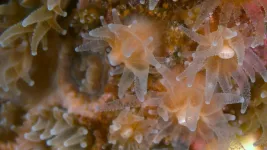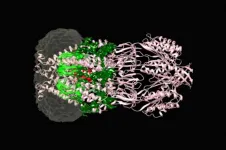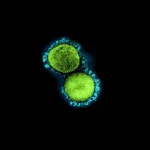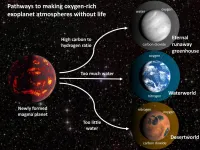INFORMATION:
About Woods Hole Oceanographic Institution
The Woods Hole Oceanographic Institution (WHOI) is a private, non-profit organization on Cape Cod, Massachusetts, dedicated to marine research, engineering, and higher education. Established in 1930, its primary mission is to understand the ocean and its interaction with the Earth as a whole, and to communicate an understanding of the ocean's role in the changing global environment. WHOI's pioneering discoveries stem from an ideal combination of science and engineering--one that has made it one of the most trusted and technically advanced leaders in basic and applied ocean research and exploration anywhere. WHOI is known for its multidisciplinary approach, superior ship operations, and unparalleled deep-sea robotics capabilities. We play a leading role in ocean observation and operate the most extensive suite of data-gathering platforms in the world. Top scientists, engineers, and students collaborate on more than 800 concurrent projects worldwide--both above and below the waves--pushing the boundaries of knowledge and possibility. For more information, please visit http://www.whoi.edu
About Roger Williams University
Roger Williams University, located on the coast of Bristol, RI, is a forward-thinking private university with 45 undergraduate majors and more than a dozen graduate programs spanning the liberal arts and the professions, where students become community-minded citizens through project-based, experiential learning. With small classes, direct access to faculty and boundless opportunities for real-world projects, RWU students develop the ability to think critically while simultaneously building the practical skills that today's employers demand. In addition to its 4,000 undergraduates and 300 graduate students, RWU is home to a thriving University College based in Providence as well as Rhode Island's only law school. Roger Williams University is committed to creating and supporting an intellectual community devoted to teaching and learning and providing the opportunity for personal and intellectual growth for students, faculty and staff. For more information, please visit http://www.rwu.edu.
Authors: Shavonna M. Bent1,2, Carolyn A. Miller1, Koty H. Sharp3, Colleen M. Hansel1, and Amy Apprill1
Affiliations:
1 Woods Hole Oceanographic Institution, Woods Hole, MA, USA
2 Johnson State College, Johnson, VT, USA
3 Roger Williams University, Bristol, RI, USA
Northern Star Coral study could help protect tropical corals
Rhode Island considers naming the local coral as a state emblem
2021-04-13
(Press-News.org) As the Rhode Island legislature considers designating the Northern Star Coral an official state emblem, researchers are finding that studying this local creature's recovery from a laboratory-induced stressor could help better understand how to protect endangered tropical corals.
A new study published today in mSystems, a journal of the American Society for Microbiology, investigates antibiotic-induced disturbance of the coral (Astrangia poculata) and shows that antibiotic exposure significantly altered the composition of the coral's mucus bacterial microbiome, but that all the treated corals recovered in two weeks in ambient seawater.
The stony Northern Star Coral naturally occurs off the coast of Rhode Island and other New England states in brown colonies with high (symbiotic) densities and in white colonies with low (aposymbiotic) densities of a symbiotic dinoflagellate alga. The study found that those corals with algal symbionts - organisms that are embedded within the coral's tissue and are required by tropical corals to survive - recovered their mucus microbiomes more consistently and more quickly.
The study also identified six bacterial taxa that played a prominent role in reassembling the coral back to its healthy microbiome. This is the first microbiome manipulation study on this coral.
"The work is important because it suggests that this coral may be able to recover its mucus microbiome following disturbance, it identifies specific microbes that may be important to assembly, and it demonstrates that algal symbionts may play a previously undocumented role in the microbial recovery and resilience to environmental change," the paper states.
With thermal bleaching and disease posing major threats to tropical corals, this research, along with other work on tropical corals, "provides a major step toward identifying the microbiome's roles in maintaining coral resilience," the paper notes.
"We think that the algae are helping the coral select the microbes that live with it, and this suggestion of symbiont-microbe coordination following disturbance is a new concept for corals," said paper co-author Amy Apprill, associate scientist at the Woods Hole Oceanographic Institution.
"Worldwide, coral reefs are in crisis. Any time we see corals recover, that's always good news. It shows that they can combat a stressor and figure out how to become healthy again," said Apprill. "What we found here is translatable to tropical corals which are faced with different stressors, such as warming water, disease, and pollution. This paper suggests that the symbiotic algae play a major role in providing consistency and resilience to the coral microbiome."
"When we think about corals, it's usually assumed that we're thinking about the tropics and the bright blue water and where it's warm, sunny, and sandy. However, the Northern Star Coral lives in murkier and much colder waters, yet it can still teach us a lot about expanding our understanding of corals," said lead author Shavonna Bent, a student in the MIT-WHOI Joint Program in Oceanography/Applied Ocean Science and Engineering.
The Northern Star Coral is an ideal emblem for Rhode Island, said co-author Koty Sharp. The coral is small like the state; it's New England-tough in dealing with large temperature fluctuations; and it's a local, offering plenty of insight that can help address global problems, said paper co-author Koty Sharp, an associate professor at Roger Williams University who is leading the effort for official designation of the coral.
Committees from both the Rhode Island House and Senate have held hearings on the proposed legislation. The Senate has approved the bill, and the House could vote on it in the coming month. Assuming the House also approves the bill, it will be sent to Rhode Island Gov. Daniel McKee for signing into law.
Sharp said the designation effort has a big educational component. "If designating this as a state emblem allows us to teach more people about the power of basic research to support conservation, or if this allows us to teach a generation of school children about the local animals that live around them, then this state coral will have a great deal of value," she said.
ELSE PRESS RELEASES FROM THIS DATE:
Study of US tuna fisheries explores nexus of climate change, sustainable seafood
2021-04-13
A new study published in Elementa by researchers at the University of California, Santa Cruz and NOAA examines traditional aspects of seafood sustainability alongside greenhouse gas emissions to better understand the "carbon footprint" of U.S. tuna fisheries.
Fisheries in the United States are among the best managed in the world, thanks to ongoing efforts to fish selectively, end overfishing, and rebuild fish stocks. But climate change could bring dramatic changes in the marine environment that threaten seafood productivity and sustainability. That's one reason why researchers ...
Researchers develop new method for putting quantum correlations to the test
2021-04-13
Physicists from Swansea University are part of an international research collaboration which has identified a new technique for testing the quality of quantum correlations.
Quantum computers run their algorithms on large quantum systems of many parts, called qubits, by creating quantum correlations across all of them. It is important to verify that the actual computation procedures lead to quantum correlations of desired quality.
However, carrying out these checks is resource-intensive as the number of tests required grows exponentially with the number of qubits involved.
Researchers from the College of Science, working with colleagues from Spain ...
Novel guidelines help select optimal deconvolution method
2021-04-13
Biomedical scientists are increasingly using deconvolution methods, those used to computationally analyze the composition of complex mixtures of cells. One of their challenges is to select one method that is appropriate for their experimental conditions among nearly 50 available.
To help with method selection, researchers at Baylor College of Medicine and the Jan and Dan Duncan Neurological Research Institute at Texas Children's Hospital have extensively evaluated 11 deconvolution methods that are based on RNA-sequencing (RNA-seq) data analysis, determining each method's ...
Inside the protein channel that keeps bacteria alive
2021-04-13
Almost all bacteria rely on the same emergency valves--protein channels that pop open under pressure, releasing a deluge of cell contents. It is a last-ditch effort, a failsafe that prevents bacteria from exploding and dying when stretched to the limit. If we understood how those protein channels worked, antibiotic drugs could be designed to open them on demand, draining a bacterium of its nutrients by exploiting a floodgate common to many species.
But these channels are tricky to operate in the lab. And how precisely they open and close, passing through a sub-conducting state and ending in a desensitized state under the influence of mechanical forces, remains poorly understood. Now, new research from ...
COVID-19 in our dust may help predict outbreaks, study finds
2021-04-13
A study done in rooms where COVID-19 patients were isolated shows that the virus's RNA - part of the genetic material inside a virus - can persist up to a month in dust.
The study did not evaluate whether dust can transmit the virus to humans. It could, however, offer another option for monitoring COVID-19 outbreaks in specific buildings, including nursing homes, offices or schools.
Karen Dannemiller, senior author of the study, has experience studying dust and its relationship to potential hazards like mold and microbes.
"When the pandemic started, we really wanted to find a way that we could help ...
NIH experts discuss post-acute COVID-19
2021-04-13
WHAT:
Many people who have COVID-19 make a full recovery and return to their baseline state of health; however, some people have symptoms or other sequelae weeks or months after initial SARS-CoV-2 infection. These heterogeneous symptoms were the subject of the virtual "Workshop on Post-acute Sequelae of COVID-19" hosted on Dec. 2 and 4, 2020, by the National Institute of Allergy and Infectious Diseases (NIAID), in collaboration with other institutes and centers of the National Institutes of Health. A paper published recently in Annals of Internal Medicine ...
Researchers reveal aging signatures across diverse tissue cells in mice
2021-04-13
Researchers have identified molecular signatures of the aging process in mice, publishing their results today in the open-access eLife journal.
Their analyses provide one of the most comprehensive characterisations of the molecular signatures of aging across diverse types of cells from different tissues in a mammal, and will aid future studies on aging and related topics.
Aging leads to the decline of major organs and is the main risk factor for many diseases, including cancer, cardiovascular and neurodegenerative diseases. While previous studies have highlighted different hallmarks of the aging process, the underlying molecular and cellular mechanisms ...
Study warns of 'oxygen false positives' in search for signs of life on other planets
2021-04-13
In the search for life on other planets, the presence of oxygen in a planet's atmosphere is one potential sign of biological activity that might be detected by future telescopes. A new study, however, describes several scenarios in which a lifeless rocky planet around a sun-like star could evolve to have oxygen in its atmosphere.
The new findings, published April 13 in AGU Advances, highlight the need for next-generation telescopes that are capable of characterizing planetary environments and searching for multiple lines of evidence for life in addition to detecting oxygen.
"This ...
What's in it for us: added value-based approach towards telehealth
2021-04-13
After interviewing various stakeholders from public and private healthcare systems (in Lithuania and the US), researchers Dr Agne Gadeikiene, Prof Asta Pundziene, Dr Aiste Dovaliene from Kaunas University of Technology (KTU), Lithuania designed a detailed structure revealing added value of remote healthcare services, i.e. telehealth. Adopting the concept of value co-creation common in business research to healthcare, the scientists claim that this is the first comprehensive analysis of this kind in the healthcare field involving two different healthcare systems.
According to the researchers, although in the US the consultations via phone with physician have been available for more than fifty ...
Gene therapy shows promise in treating rare eye disease in mice
2021-04-13
A gene therapy protects eye cells in mice with a rare disorder that causes vision loss, especially when used in combination with other gene therapies, shows a study published today in eLife.
The findings suggest that this therapy, whether used alone or in combination with other gene therapies that boost eye health, may offer a new approach to preserving vision in people with retinitis pigmentosa or other conditions that cause vision loss.
Retinitis pigmentosa is a slowly progressive disease, which begins with the loss of night vision due to ...
LAST 30 PRESS RELEASES:
Sleeping in on weekends may help boost teens’ mental health
Study: Teens use cellphones for an hour a day at school
After more than two years of war, Palestinian children are hungry, denied education and “like the living dead”
The untold story of life with Prader-Willi syndrome - according to the siblings who live it
How the parasite that ‘gave up sex’ found more hosts – and why its victory won’t last
When is it time to jump? The boiling frog problem of AI use in physics education
Twitter data reveals partisan divide in understanding why pollen season's getting worse
AI is quick but risky for updating old software
Revolutionizing biosecurity: new multi-omics framework to transform invasive species management
From ancient herb to modern medicine: new review unveils the multi-targeted healing potential of Borago officinalis
Building a global scientific community: Biological Diversity Journal announces dual recruitment of Editorial Board and Youth Editorial Board members
Microbes that break down antibiotics help protect ecosystems under drug pollution
Smart biochar that remembers pollutants offers a new way to clean water and recycle biomass
Rice genes matter more than domestication in shaping plant microbiomes
Ticking time bomb: Some farmers report as many as 70 tick encounters over a 6-month period
Turning garden and crop waste into plastics
Scientists discover ‘platypus galaxies’ in the early universe
Seeing thyroid cancer in a new light: when AI meets label-free imaging in the operating room
Neutrophil-to-lymphocyte ratio may aid risk stratification in depressive disorder
2026 Seismological Society of America Annual Meeting
AI-powered ECG analysis offers promising path for early detection of chronic obstructive pulmonary disease, says Mount Sinai researchers
GIMM uncovers flaws in lab-grown heart cells and paves the way for improved treatments
Cracking the evolutionary code of sleep
Medications could help the aging brain cope with surgery, memory impairment
Back pain linked to worse sleep years later in men over 65, according to study
CDC urges ‘shared decision-making’ on some childhood vaccines; many unclear about what that means
New research finds that an ‘equal treatment’ approach to economic opportunity advertising can backfire
Researchers create shape-shifting, self-navigating microparticles
Science army mobilizes to map US soil microbiome
Researchers develop new tools to turn grain crops into biosensors
[Press-News.org] Northern Star Coral study could help protect tropical coralsRhode Island considers naming the local coral as a state emblem




